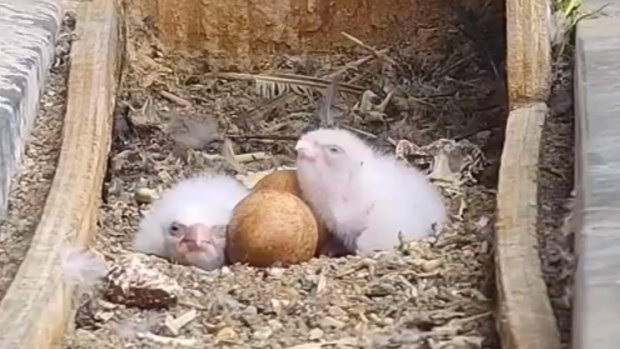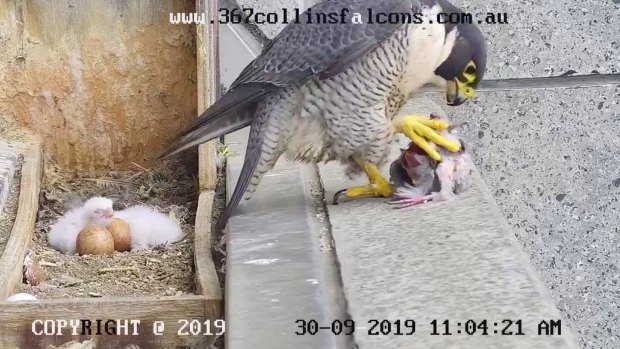By Carolyn Webb
It’s not easy being a parent in the inner city. From the day the kids are born, they need shelter and love. It’s all ‘‘me, me, me’’.
And every day, you have to go out and hunt and kill a pigeon, and tear apart its carcass to feed them.
OK, so that last bit is (hopefully) not the case for human parents but it describes life for the next month for Melbourne’s famous CBD peregrine falcon pair.

Baby peregrine falcon nestlings on Monday on Level 33, 367 Collins Street, Melbourne.
For now, it’s ‘break out the champagne’ because the loved-up couple, whose nest is a ledge is high up on a Collins Street skyscraper, have just hatched two little ‘‘eyases’’ — baby peregrine falcons — and two eggs are yet to hatch.
Thousands of devoted fans are losing sleep and forgetting to work, watching their ‘‘murder pom-poms’’ as some have dubbed the eyases, via a 24-hour webcam.
Much of it involves Mum or Dad taking turns to sit on the eggs or nestlings.
But there are spikes of drama when one parent returns with dinner — a bloody wing or torso of a street bird they have just ripped to pieces.
This sort of gory scene did not faze Vicki Hams, a member of the Facebook page ‘367 Collins Falcon Watchers’ which has more than 4000 subscribers: ‘‘When she [the mother] took the bird chunk to the nest you could just see her gently picking bits off and I assume feeding, ’’ Ms Hams posted. ‘‘It was very cool! Fingers crossed not a diseased bird chunk!’’
Last year’s breeding season was an emotional rollercoaster for followers, when three of the same couple’s eggs hatched, only for two nestlings to die at about four weeks old.
Peregrine Falcon expert Dr Victor Hurley, who has managed the nest site for 27 years, said the deaths were probably due to diseased city birds the nestlings ingested.

A female peregrine falcon brings back a fresh kill for her hatchlings in their nest at 367 Collins Street, Melbourne
But there was jubilation when the third nestling successfully grew its full quota of feathers and the camera captured it fledging (flying off) that ledge 33 floors up.
Hatched eyases depend on their parents until they are about 35 to 42 days old.
That’s when parents get tough: to get the offspring to fly, they will often stop feeding them, then fly past the ledge holding a morsel of food, daring them to fly over and get it.
Dr Hurley says the ‘‘kids’’ return to the nest every night for a month or two after they’ve started flying ‘‘for somewhere to sleep but after they’ve had their first kill, the adults tend to stop feeding them and will chase them out of the territory.

Melbourne's resident falcons have expanded their family, with new chicks hatching at 367 Collins Street.
‘‘There’s none of this having kids hanging around till they're 35, raiding the fridge and living at home. They lock the doors, change the lock on the fridge and kick them out. They’re pretty brutal about that.’’
Kathryn Reinheimer, a marriage celebrant, of Yarraville, said this is the second year she has followed the live feed; she watches on her iPad as she works from home.
On Monday afternoon, the mother falcon left the eggs, ‘‘and I was getting worried that no one was coming back. I was thinking, ‘those eggs have to be kept warm, come on, what are you doing, come on, get back, get back!’’
‘‘You become obsessed. It’s a peek into nature. It’s not a zoo, it’s not set-up. And it’s sad – they lost two out of three last year. I think I might have to turn off this year if they start getting sick because it’s actually quite distressing.’’
Dr Hurley said people are fascinated that it’s ‘‘a wild animal wanting to breed in the middle of the city’’.
‘‘It’s something that Melbourne has really latched hold of. It’s become a Melbourne story, which is nice.’’
He hopes it encourages viewers to take a wider interest in the environment. ‘‘I’d like to think there’s a sense about, ‘wow I wonder how the rest of nature, or the rest of this species’ population is going elsewhwere'. And if this is a step in that direction, then that’s a good thing.’’
‘‘I think people do care about the natural world. They just don’t see it enough. This is, in most people’s minds, so unusual.’’